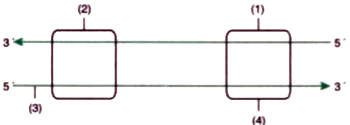DNA strands are antiparallel because of the presence of :
H-bonds
Phosphate diester-bonds
Di-sulphide-bonds
Phosphate-bonds
The correct Answer is:D
Step-by-Step Solution:
1. Understanding DNA Structure: DNA is composed of two strands that run in opposite directions. Each strand consists of a backbone made of sugar and phosphate groups, with nitrogenous bases attached to the sugar.
2. Identifying the Directionality: Each DNA strand has a directionality indicated by the 5' (five prime) and 3' (three prime) ends. The 5' end has a phosphate group, while the 3' end has a hydroxyl group.
3. Defining Antiparallel Orientation: The two strands of DNA are said to be antiparallel because one strand runs from 5' to 3', while the other runs from 3' to 5'. This orientation is crucial for the formation of base pairs.
4. Role of Bonds in DNA Structure: There are three main types of bonds in DNA:
- N-glycosidic bonds: Connect nitrogenous bases to the sugar.
- Phosphodiester bonds: Link the sugar-phosphate backbone of adjacent nucleotides.
- Hydrogen bonds: Form between complementary nitrogenous bases (adenine with thymine, and guanine with cytosine).
5. Significance of Hydrogen Bonds: The hydrogen bonds between the nitrogenous bases stabilize the DNA structure. They allow for the base pairing that is essential for the double helix formation.
6. Conclusion: The antiparallel nature of DNA strands is primarily due to the presence of hydrogen bonds between the complementary bases, which ensures proper base pairing and stability of the DNA molecule.
Final Answer: The DNA strands are antiparallel because of the presence of hydrogen bonds.
---
- N-glycosidic bonds: Connect nitrogenous bases to the sugar.
- Phosphodiester bonds: Link the sugar-phosphate backbone of adjacent nucleotides.
- Hydrogen bonds: Form between complementary nitrogenous bases (adenine with thymine, and guanine with cytosine).
Topper's Solved these Questions
- GENETICS & MOLECULAR BASIS OF INHERITANCE AND MUTATIONBOOK - ALLENCHAPTER - GENETICS & MOLECULAR BASIS OF INHERITANCE AND MUTATIONEXERCISE - EXERCISE-II (PREVIOUS YEAR QUESTIONS
104 Videos
- GENETICS & MOLECULAR BASIS OF INHERITANCE AND MUTATIONBOOK - ALLENCHAPTER - GENETICS & MOLECULAR BASIS OF INHERITANCE AND MUTATIONEXERCISE - EXERCISE-III (ANALYTICAL QUESTIONS
85 Videos
- GENETICS & MOLECULAR BASIS OF INHERITANCE AND MUTATIONBOOK - ALLENCHAPTER - GENETICS & MOLECULAR BASIS OF INHERITANCE AND MUTATIONEXERCISE - DEGINNERS BOX-8
5 Videos
- GENETICS BOOK - ALLENCHAPTER - GENETICS EXERCISE - Question
58 Videos
- GENETICS (PRINCIPLES OF INHERITANCE AND VARIATION) (MOLECULAR BASIS OF INHERITANCE)BOOK - ALLENCHAPTER - GENETICS (PRINCIPLES OF INHERITANCE AND VARIATION) (MOLECULAR BASIS OF INHERITANCE)EXERCISE - Question
53 Videos
Similar Questions
Knowledge Check
In DNA strand, the nucleotides are linked together by
Aglycosidic bondsBphosphodiester bondsCpeptide bondsDhydrogen bonds.
DNA strands are termed antilparallel be cause of
View SolutionDNA strands are joined by
View Solution$ The two strands of DNA run in an antiparallel directions
DNA is formed of Deoxyribose sugar. Phosphorus and nitrogen bases called purines and pyrimidines.
View SolutionAntiparallel strands in DNA is due to
View SolutionAntiparallel strands of a DNA molecule means that :
View SolutionWhat do you understand by the antiparallel arrangement of DNA strands?
View SolutionIn the following diagram the two DNA strands represented are ready for transcription.
Which one of the two strands of DNA has nucleotide sequence similar to mRNA that will be transcribed and why?

View Solution
